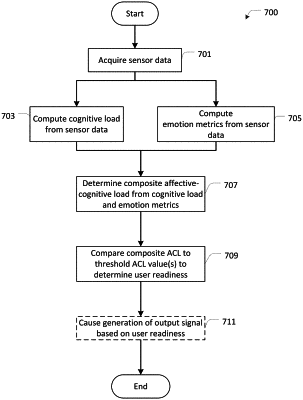| CPC B60W 60/0013 (2020.02) [B60W 40/08 (2013.01); G06F 3/013 (2013.01); G06F 3/015 (2013.01); G06V 20/597 (2022.01); B60W 2540/22 (2013.01); B60W 2540/221 (2020.02); B60W 2540/229 (2020.02); G06F 2203/011 (2013.01)] | 19 Claims |

|
1. A computer-implemented method comprising:
receiving, from at least one sensor, sensor data associated with an environment;
computing, based on the sensor data, a cognitive load value associated with a user within the environment;
computing, based on the sensor data, an arousal value and a valence value associated with an emotional state of the user;
multiplying the valence value by a combination of the cognitive load value and the arousal value to generate an affective-cognitive load;
comparing the affective-cognitive load with one or more thresholds to determine a user readiness state associated with the user; and
modifying a vehicle operation to assist the user in performing a driving action to a degree that corresponds to the user readiness state.
|